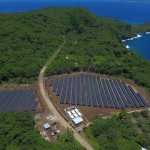
WHY THIS MATTERS IN BRIEF
Over 1 billion people live without electricity, and the cost of reaching them using traditional energy infrastructures is prohibitive, renewables offer an affordable, and increasingly realistic alternative.
With over 1 billion people on our planet still living without electricity, and billions more living with unreliable power Elon Musk has held few punches in believing that it’s high time the world moves away from fossil fuels and embraces renewable energy. So much so that he’s even done the maths, he believes that energy requirements for the entire world could be met by building 100 of his famous gigafactories and it looks like he’s trying to hammer his point home – using the remote island of Ta’u in American Samoa.
As anyone will tell you here are challenges to living on a remote island – food scarcity and destructive weather are just the beginning, the lack of affordable, reliable power is another and the island of Ta’u, located more than 4,000 miles from the West Coast of the US, is no stranger to power rationing and outages.
“I recall a time they weren’t able to get the boat that carries the diesel out to us for two months,” said Keith Ahsoon, a local resident whose family owns one of the food stores on the island.
“We rely on that boat for everything, including importing diesel for the generators for all of our electricity. Once diesel gets low, we try to save it by using it only for mornings and afternoons. Water systems here also use pumps, everyone in the village uses and depends on that. It’s hard to live not knowing what’s going to happen. I remember growing up using candlelight. And now, in 2016, we were still experiencing the same problems.”
But the situation is changing. Ta’u now hosts a solar power and battery storage enabled microgrid that can supply nearly 100 percent of the island’s power needs from renewable energy, providing a cost-saving alternative to diesel, removing the hazards of power intermittency and making outages a thing of the past.
The microgrid – 1.4 megawatts of solar generation capacity from SolarCity and Tesla and 6 megawatt hours of battery storage from 60 Tesla Powerpacks took just one year to implement and the benefits are life changing for residents of Ta’u. The local hospital, high school and elementary schools, fire and police stations and local businesses no longer need to worry about outages or rationing, but one of the biggest advantage is cost – Tau’s microgrid replaces diesel generators with more affordable solar energy, and is designed to optimize system performance and maximize savings.
“It’s always sunny out here, and harvesting that energy from the sun will make me sleep a lot more comfortably at night, just knowing I’ll be able to serve my customers,” said Ahsoon.
Like Ta’u, many communities across the globe use diesel as their main source of power. Today, microgrid solutions featuring solar power and energy storage cost less than diesel almost anywhere in the world and are a cleaner, safer alternative. Solar and storage systems also eliminate expenses and issues associated with shipping diesel and provide stable power costs for decades, unlike fluctuating fossil fuel prices – all by simply switching to the power of the sun.
The stability and affordability of power from the new Ta’u microgrid, operated by American Samoa Power Authority, provides energy independence for the nearly 600 residents of Ta’u. The battery system also allows the island to use stored solar energy at night, meaning renewable energy is available for use around the clock.
The project was funded by the American Samoa Economic Development Authority, the Environmental Protection Agency, and the US Department of Interior, and is expected to allow the island to save significantly on energy costs. The system is expected to offset the use of more than 109,500 gallons of diesel per year. Factoring in the escalating cost of fuel, along with transporting such mass quantities to the small island, the financial impact is substantial.
“This is part of making history. This project will help lessen the carbon footprint of the world. Living on an island, you experience global warming firsthand. Beach erosions and other noticeable changes are a part of life here. It’s a serious problem, and this project will hopefully set a good example for everyone else to follow,” said Ahsoon.
Ta’u is not a postcard from the future, it’s a snapshot of what is possible right now and as renewable power technologies and microgrids mature they will inevitably become the defacto solution for a growing number of locations and islands that have traditionally relied on fossil fuels.



















[…] power has proved a godsend for remote islands such as Ta’u, part of America Samoa, in the South Pacific. Once reliant on imports of vast amounts of diesel, it […]